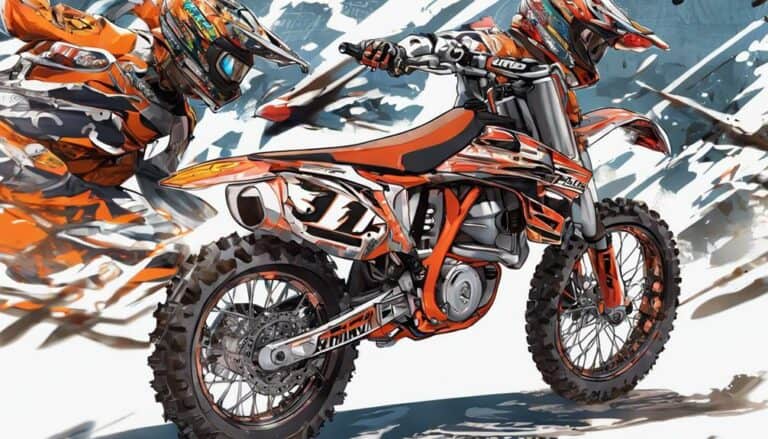Did you know that a top-of-the-line dirt bike can cost up to $20,000 or more?
The price tag of dirt bikes often raises eyebrows, especially when compared to sportbikes; however, there are clear reasons behind this disparity.
From the specialized components required for off-road performance to the rigorous testing and development processes involved, understanding the intricacies of what makes dirt bikes more expensive than sportbikes can shed light on the investment required for these rugged machines.
Key Takeaways
- Specialized engineering for off-road performance increases production costs.
- Premium materials and state-of-the-art construction enhance durability.
- Brand value and marketing strategies influence pricing decisions.
- High market demand for rugged terrain capabilities drives pricing trends.
Production Costs of Dirt Bikes
Due to their limited production and the utilization of high-quality materials and innovative technology, dirt bikes incur heightened production costs compared to other types of motorcycles. The small bore, limited production volume, and focus on quality components like frames, suspension, wheels, and brakes all contribute to the elevated production expenses of dirt bikes.
Manufacturers prioritize using high-quality materials to guarantee durability and performance, further driving up costs. The exclusive nature of dirt bikes, stemming from their limited production, adds to their appeal but also increases the price tag due to the specialized manufacturing processes involved. Balancing the need for high-quality components and cutting-edge technology with the demands of off-roading standards results in a bespoke experience for riders, but one that comes at a premium cost.
These factors combine to create a niche market for dirt bikes, where quality and exclusivity come hand in hand with heightened production costs.
Technology Gap Between Dirt and Sport Bikes
The distinctive technological requirements of dirt bikes for off-road performance create a notable gap in engineering and design when compared to sport bikes focused on high-speed paved road capabilities. Dirt bikes incorporate specialized technology such as advanced suspension systems and rugged components to prioritize durability and traction in challenging off-road conditions. These technological features are essential for handling rough terrains and jumps, setting them apart from sport bikes designed for smooth, high-speed rides on paved roads.
This technology gap between dirt bikes and sport bikes influences manufacturing processes and pricing. Dirt bikes require specialized engineering to withstand the rigors of off-road riding, leading to higher production costs. The advanced technology integrated into dirt bikes for off-road performance contributes to their higher price tags compared to sport bikes. The unique design priorities driven by the different technological needs of each type of motorcycle result in a pricing disparity that reflects the specialized nature of dirt bikes, engineering, and manufacturing.
Materials and Durability Factors
Enhancing dirt bikes with premium materials like carbon fiber, magnesium, titanium, and aluminum greatly boosts their durability and off-road performance capabilities. These materials are carefully selected to withstand the harsh conditions encountered during off-road riding, making dirt bikes more resilient than sport bikes. The state-of-the-art engineering and premium features incorporated into dirt bikes guarantee that they can tackle rugged terrains with ease, offering riders a durable and reliable machine for their adventures.
Dirt bikes are engineered with a focus on durability, utilizing advanced materials that not only enhance performance but also prolong the lifespan of the bike. The use of these high-quality materials comes at a premium cost, but the benefits regarding longevity and ruggedness justify the higher price tag. Compared to sport bikes, the specialized construction of dirt bikes with these premium materials ensures they can endure the demands of off-road riding, making them a preferred choice for those seeking durability and performance in their biking experience.
Brand Value and Marketing Strategies
Turning our focus to brand value and marketing strategies, one can't overlook the pivotal role they play in determining the pricing discrepancies between dirt bikes and sport bikes.
Key Points:
- Brand Value: Dirt bike manufacturers leverage their established reputation and brand recognition within the off-road industry to justify premium pricing.
- Marketing Strategies: The strategic positioning of dirt bike brands as high-performance and rugged machines influences pricing decisions, emphasizing their premium branding.
- Pricing Decisions: The perceived value created through marketing efforts and premium branding strategies drives up the cost of dirt bikes when compared to sport bikes.
Dirt bike companies invest heavily in cultivating a strong brand image and implementing effective marketing strategies to differentiate themselves in the competitive off-road industry. This not only justifies their higher pricing but also creates a perception of superior quality and performance, contributing to the pricing disparities between dirt bikes and sport bikes.
Market Demand and Pricing Trends
Market demand and pricing trends for dirt bikes and sport bikes illustrate the impact of specialized engineering and consumer preferences on their respective costs.
The high market demand for off-road performance and rugged terrain capabilities drives the pricing trends of dirt bikes. Manufacturers invest in advanced features, durable components, and innovative technology to meet consumer preferences for quality and reliability, leading to higher manufacturing costs. The niche market for dirt bikes prioritizes off-road performance, which contributes to the premium pricing compared to sport bikes.
Consumer preferences for extreme sports and adventurous off-road experiences further elevate the pricing of dirt bikes. These factors combine to create a pricing trend where dirt bikes are more expensive than sport bikes due to the specialized engineering, manufacturing costs, and premium pricing driven by consumer demand for off-road performance.
Conclusion
To sum up, when it comes to the price difference between dirt bikes and sportbikes, it all boils down to supply and demand. The old saying goes, 'you get what you pay for,' and in the case of dirt bikes, the higher cost reflects their superior build quality, advanced technology, and overall performance capabilities.
So, if you want high-quality features and durability in your bike, be prepared to dig a little deeper into your wallet for a dirt bike.

